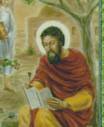Matthew the Apostle
 From Conservapedia - Reading time: 2 min
From Conservapedia - Reading time: 2 min
Matthew the Apostle (Saint Matthew in Catholic and Orthodox traditions) is the writer of the first Gospel in the New Testament, The Gospel of Matt.hew]]. The name Matthew is derived from the Hebrew Mattija. He was one of the Jesus' twelve disciples and became one of the more prominent Apostles.
Due to Matthew's background as a tax collector, the parables he recounts in his Gospel of Matthew tend to be more economic in nature than in the other Gospels, such as the Parable of the Vineyard Workers that appears only in his Gospel.
Feastday: September 21, November 16.
He is mentioned five times in the New Testament, once concerning his call (Matthew 9:9) and four other times in lists of the twelve (Luke 6:15, Mark 3:18, Matthew 10:3, Acts 1:13). His call is also recorded in Mark 2:14 and Luke 5:27, where he is called Levi. However, some scholars dispute whether Levi was the same person as Matthew.[1]
Matthew was the son of Alpheus, a Galilean, and a tax collector by trade. Such a job was often associated with extortion and was therefore regularly despised, especially by the Pharisees. When called by Jesus, he was sitting at a customhouse. Matthew arose and followed the Lord, setting for him a feast in his house, where other tax collectors and sinners reclined at table with Jesus and his disciples. This prompted a rebuke from the Pharisees, whereupon Jesus responded, "I came not to call the just, but sinners."
No more specific information concerning Matthew is found in the gospels though as one of the twelve he accompanied Jesus up to the time of His Passion and was one of the witnesses of the Last Supper and His Resurrection. He was also among the Apostles who were present at the Ascension, and afterwards withdrew to an upper chamber, in Jerusalem, praying in union with Mary, the Mother of Jesus, and with his brethren (Acts 1:10 and 1:14). [2]
From the Church Fathers we learn that Matthew composed his gospel first, and we are also given the tradition that he preached the Gospel among the Jews and eventually evangelized the region south of the Caspian Sea. Other traditions add Persia, Macedonia, and Syria. All ancient testimony, with the exception of Heracleon, states that he died a martyr.
In the traditional symbolization of the evangelists (based on Ezech. 1:5-10 and Rev. 4:6-7) the image of the winged man is accorded to Matthew because his Gospel begins with the human genealogy of Christ.
See also[edit]
External links[edit]
- St. Matthew Catholic Encyclopedia.
 KSF
KSF